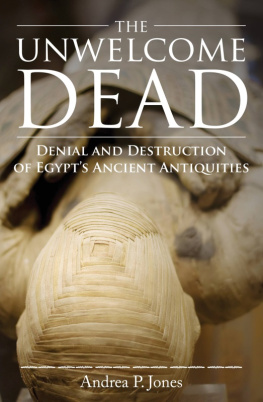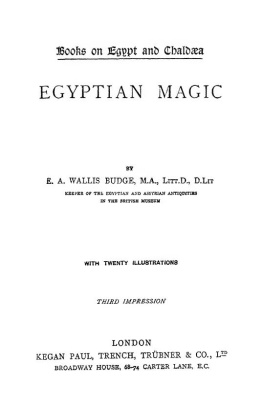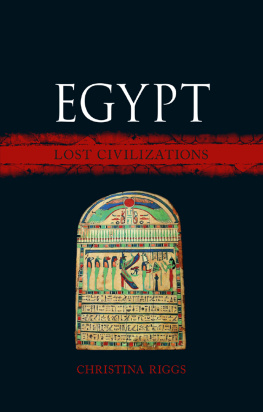ISBN: 978-1-948282-02-4 - Paperback
978-1-948282-03-1 - Hardcover
978-1-948282-04-8 - eBook
The Unwelcome Dead: Denial and Destruction of Egypts Ancient Antiquities
Copyright 2014 by Andrea P. Jones
All rights reserved.
No part of this publication may be reproduced, distributed, or transmitted in any form or by any means, including photocopying, recording, or other electronic or mechanical methods, without the prior written permission of the publisher, except in the case of brief quotations embodied in critical reviews and certain other noncommercial uses permitted by copyright law.
For permission requests, write to the publisher at the address below.
Yorkshire Publishing
3207 South Norwood Avenue
Tulsa, Oklahoma 74135
www.YorkshirePublishing.com
918.394.2665
ACKNOWLEDGMENTS
I would like to thank my family and friends for always supporting me, my parents and my brother and sister for always believing in me, my grandmother for staying up with me to read over my work, and my aunt Lisa for all of her help and support.
CONTENTS
INTRODUCTION
RESEARCH PROBLEM AND QUESTIONS
CONFLICTING MEANINGS OF LAND AND HISTORY
This book is an analysis of narratives about how differing conceptions of history and land are negotiated in contested archaeological spaces, using the Egyptian village of Kom Trougah as a case study. Kom Trougah is a village as well as an archaeological site, wherein different, and often times competing, histories are produced by its villagersthe Hungarian mission excavating the site and the Supreme Council of Antiquities (SCA). There are at stake certain perceptions of time, space, and identity that have been formed on national and local levels. I am interested in the way historical discourses of power, nostalgia, religion, and culture have continued to shape and reshape the site of Kom Trougah.
This project begins with the assumption that it is important to understand the effects of the significance placed by Europeans on such historical places, in particular through ideologies of caring for the past and its artifacts. It is equally important to understand the conflicting emotions and socioeconomic forces that are stirred by appeals to the value of the past, which leads to pressing questions about who owns the interpretation of historyand the interpretation of Kom Trougah. My goal here is to evaluate the productive differences operating at Kom Trougah that make it both a symbolic system and a field of complex historical layers, which require interpretation and attention to the narratives at work.
It is worth noting at the outset that many foreigners and Egyptians often point to villagers as a main threat to the work of archaeology at Egyptian archaeological sites, yet often the villagers are not interviewed. This book is an ethnographic study that seeks to understand and rethink the narratives of land and history to include those collected from villagers and local government officials and in turn, how what we gain from those views can shape our perceptions of the archaeological issues. My work begins from the premise that the village is not a monolithic entity but rather is made up of people who are uniquely positioned to direct our understanding of the ideological and historical pressures informing the site.
This book was written prior to the recent revolution in Egypt. The impact of changes across the country regarding the archaeological sites is not yet known, but it is unlikely that positive changes toward protecting the archaeology are being made.
THE SUPREME COUNCIL OF ANTIQUITIES (SCA) IN KOM TROUGAH
The SCA is the governing body responsible for protecting, recording, and overseeing all the archaeological sites, monuments, and artifacts in Egypt. The SCA is a branch of the Egyptian government, which falls under the Ministry of Culture. It has a highly politicized role, nationally and internationally, and controls who can excavate and where excavations can be conducted. The SCA also defines and oversees archaeological sites within Egypt. SCA inspectors and guards are employed to monitor these sites and are responsible for their daily protection against theft, vandalism, and damage. The guards travel to the site daily. They are responsible for protecting the site from daily threats, reporting any problems to the inspectors. The inspectors visit the site weekly. They are responsible for reporting to the SCA any damage or potential threats to the sites. The SCA employees work closely with the national police.
Between the years 1858 and 1908, Europeans working with Egyptians founded the Egyptian Antiquities Service, which later became the Supreme Council of Antiquities or SCA (Reid 2002, 1).
Learning about archaeology primarily from the Europeans, Egyptians gradually came to realize that it could be turned to their own ends. Once persuaded of the vital role archaeology could play in shaping their modern national identity, Egyptians began searching for ways to train their own archaeologists. This set the stage for nationalist challenges both to European control of Egypts archaeological institutions and to Western imperialists interpretations of history. (Reid 2002, 2)
The Egyptian Egyptologist Fayza Haikal points out that European interests in ancient Egypt created a cultural dialogue between Egypt and the modern world (Haikal 2003, 123). European interests in Egyptology and Ancient Egypt were not mirrored by most Egyptians. Those Egyptians who expressed an interest in the field in this early period had been educated in foreign countries and institutions, Culturally and completely Arabized at the time, Egyptians did not care much for pre-Islamic civilizations, which they considered pagan and therefore unworthy of their attention (Haikal 2003, 123). As it has been argued,
It was at the instigation of Champollion himself, who was distressed at the rapid deterioration of the ancient monuments and at the way they were being treated by foreign or local adventurers and excavators, that Mohamed Ali Pasha, the Viceroy of Egypt, had a Service des Antiquites Egyptiennes created in 1835 to try and control the traffic of antiquities in and out of Egypt. (Haikal 2003, 123)
I would argue, based on my research in Kom Trougah, that this still holds true todaythat we must consider the situation of the SCA and the site as embroiled in questions of economic and cultural power along these lines. However, the newly created institution of the Service des Antiquites Egyptiennes was not taken seriously by Mohamed Ali Pasha or his successors, who chose to use artifacts as political gifts in exchange for knowledge and aid from Western countries (Haikal 2003, 124). It was not until 1858 when the Frenchman Auguste Mariette became director of Egyptian Antiquities that the service became effective (Haikal 2003, 124). The French would dominate the Service des Antiquites until 1936. It was under the French that the system of employing inspectors developed. They were put in charge of the excavation and protection of monuments and antiquities all over Egypt and to establish many provincial museums across Egypt (Haikal 2003, 124.) In 1936, the French still ran the antiquities service alongside the British (Haikal 2003, 124). The 1952 Revolution and the policies of Egypts second president, Gamal Abd al-Nasser, led to national control of the antiquitiess service, the archaeology, and the museums (Reid 2002, 17). In 1970, the name of the Service des Antiquites Egyptiennes was changed to The Egyptian Antiquities Organization. It was then renamed the Supreme Council of Antiquities (SCA) in the early 1990s (Haikal 2003, 124). The SCA provides about twenty thousand jobs throughout the country today (Haikal 2003, 124125).










